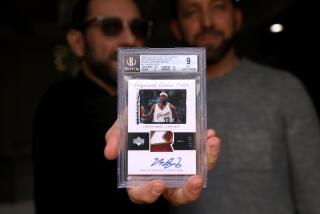Here’s change you can’t quite believe in
- Share via
So you got yourself one of those widely advertised Obama coins from Franklin Mint that’s covered in 24-carat gold and depicts the president-elect.
With it came a “certificate of authenticity,” signed by the 36th director of the U.S. Mint, Jay W. Johnson.
The good news: The coin, priced at $9.95, has guaranteed monetary value.
The bad: That guaranteed value is only 50 cents.
Also, although Johnson is a real person, he hasn’t been director of the U.S. Mint since 2001.
And your total cost is more than double the advertised $9.95.
Confusion over Obama commemorative coins -- issued not only by Franklin Mint but also several other private companies -- has become so widespread that the U.S. Mint has issued an alert.
“These items are not official United States Mint products,” says the statement.
The coins from Franklin Mint are real Kennedy half dollars upon which an image of the president-elect is superimposed.
But the U.S. Mint wants you to know, in no uncertain terms, that the agency had nothing to do with the altering or marketing.
Its statement continues: “Furthermore, these products, businesses and advertisements are not approved, endorsed, sponsored or authorized by the United States Mint, the Department of the Treasury or the United States government.”
Michael White, a spokesman for the agency, said the Mint -- which produces U.S. coins -- has had a steady stream of calls about the coins. In addition to asking whether the government was involved, callers wanted to know whether altering the coins was legal.
“It’s not illegal to alter a coin,” White said. “The guidelines have to do with fraudulent intent. As long as you don’t represent the product as anything other than an altered coin, it’s within the law.”
For example, you can’t alter a coin or paper bill to make it appear to be a higher denomination. Just adding Barack Obama’s picture is allowed.
Callers also want to know whether the coins are still legal tender. They are, White said, even though they now bear Obama’s image instead of the late John F. Kennedy’s.
It’s perfectly permissible to use the 50-cent altered coins in vending machines or in stores.
A merchant isn’t obligated to take it -- or any other coin for that matter.
“It’s like someone trying to pay a $50 parking ticket with all pennies,” White said. “It doesn’t have to be accepted.”
Johnson, who served in Congress from Wisconsin for a term before being defeated and then was appointed in 2000 to head the Mint, is aware that there can be confusion between the U.S. Mint and Franklin Mint.
Franklin Mint, in Exton, Pa., has been turning out commemoratives and other products since 1964.
“I used to tell people, ‘I’m the head of the Mint,’ ” said Johnson, who lives in suburban Washington. “And they would say, ‘I’ve heard of the Franklin Mint, is it like that?’
“I’d say, ‘No, it’s the real Mint.’ ”
Johnson, who is now chief numismatist for Franklin Mint, said he is careful to say he’s the former director of the U.S. Mint in television commercials and when he makes appearances on the Shop NBC channel, which hawks Franklin Mint products.
At least one Franklin Mint website selling the coin, however, simply lists him as the “36th director” of the federal agency. To find out he’s the former director, you have to click on a video commercial at the site in which he clarifies his past status. It also shows him signing the “certificate of authenticity.”
Just what is it about the product that’s “authentic”?
“Basically, it says that it’s a genuine, uncirculated coin that has been enhanced by the Franklin Mint,” Johnson said.
Midway through the commercial, the announcer says, in time-honored fashion, “But wait, there’s more!”
The product included “free” with the coin is the “first-time postage stamp honoring our new president.” Shown is a sheet of stamps bearing the president-elect’s image.
But don’t expect to use them -- the stamps were issued by Liberia and are good for postage only there.
Even though they’re included “free,” they add on to the cost because of shipping and handling. In fact, the total shipping and handling charges are startling: $6.95 for the coin and $4.95 more for the “free” stamps.
That brings the total charges to $11.90, or more than the listed price of the coin.
It makes the real outlay $21.85.
Johnson said he had nothing to do with setting the charges and wasn’t aware they amounted to more than the list price.
“That’s marketing,” he said.
The Professional Numismatists Guild, an association for coin dealers established in 1953, has been getting calls from consumers about the coins too.
“If they’re looking to buy a memento, that’s fine,” said Gary Adkins, president of the guild. “But they should not look at this as an investment.”
Adkins, who lives in suburban Minneapolis and has been a coin dealer for 43 years, said the altered Kennedy half dollar probably had little or no worth beyond the 50-cent face value.
“The coin is just a nickel-copper alloy, so they don’t have any gold or silver in them,” he said. “The 24-carat gold plating they advertise is really nothing. It’s like spray painting. It’s microscopic thin, so there’s no premium for that.”
Adkins said the value might grow beyond 50 cents in time but probably won’t reach $9.95, let alone $21.85.
“The thing is, you have to find someone who wants it more than you do,” he said. “Most of the time, you have to sell it for a much reduced price.
“Maybe someday you could take it to your local coin dealer, and they say, ‘We’ll give you $2 for it.’
“Then they put it in the case and sell it for $5.”
--
More to Read
Sign up for The Wild
We’ll help you find the best places to hike, bike and run, as well as the perfect silent spots for meditation and yoga.
You may occasionally receive promotional content from the Los Angeles Times.







